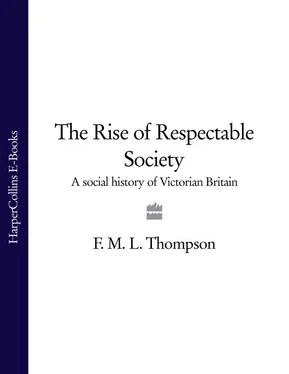In retrospect it might seem that this was a purely defensive and protective measure, the use of entrenched aristocratic power while there was yet just time to fashion a barricade of franchises and constituencies which would keep the mounting urban and industrial forces at bay, thus delaying or preventing altogether their capture of the commanding heights of society and the economy. The barrier was severely tested during the Corn Law debates of the 1840s, when the most radical wing of the Anti-Corn Law League hoped to use repeal as a lever for toppling the entire ‘aristocratic monopoly’; but it survived, thanks to the opportunism and realism of the ruling class, and lived on to shelter the anachronism of a predominantly landed control of an essentially industrial society. Such a view, however, begs many questions: in what sense the landed dominance of government, Parliament, and much of local administration was artificially contrived rather than an expression of the essence of the social order; in what sense Britain was, or became, an industrial society; and in what sense urban and industrial interests and values were in conflict with the rural and agricultural world.
In the 1830s, at any rate, it made perfectly good sense to accord the preponderant place in the political nation to the landed and rural elements. This was not just a matter of privilege, property, and tradition, but one of economic and social reality. It is true that fundamental and far-reaching changes in the scale and methods of production had been under way for the past seventy years: an older generation of historians regarded the Industrial Revolution, in its headlong pioneering phase, as complete by 1830; a younger generation, intrigued by models of economic growth, placed the take-off into self-sustained growth as long since accomplished and viewed the economy of 1830 as being at least half-way through its drive to maturity, the maturity of a modern, fully industrialized economy. All would agree that structural, technical, and organizational changes had gone so far that a wholly new kind of society was bound to develop; and all would accept G. R. Porter’s statement that ‘it is to the spinning-jenny and the steam-engine that we must look as having been the true moving powers of our fleets and armies, and the chief support also of a long-continued agricultural prosperity.’ The revolutionary character of technological innovations and their potential for producing social transformation are one thing, however; the extent and pace of their impact on the social fabric are another matter, and the key to understanding the state of society.
It was a pardonable exaggeration to claim that the spinning jenny and the steam engine had been carrying the economy on their backs since the turn of the century. Cotton goods had replaced woollens as Britain’s principal export, and the meteoric rise of the cotton industry, if not literally attributable to the jenny alone, could be justifiably ascribed to the new breed of spinning machinery, particularly the mule, and its harnessing to water and steam power. The spinning mills, the advance guard of the factory system, had momentous effects on work habits, living conditions, and social relationships, possibly more momentous and revolutionary than their effects in increasing production and creating wealth, since they were the birthplace of the industrial proletariat. Much attention was concentrated on the mills, their marvels and their miseries, their awesome grandeur and awfulness, as contemporaries commented on the apparently limitless power of machinery and speculated on the chances of society handling, or indeed surviving, the arrival of a factory population.
The curiosity and anxiety were most understandable, in face of the novelty of the development and uncertainty about what it might portend for the future. For, in 1830, the day when typical English men or women would be town dwellers, or factory workers, still lay emphatically in the future. The cotton industry was very important, it was far and away the largest factory industry, and it was growing rapidly; but its factory element was not yet all that imposing. There had been around 100,000 factory operatives in the mills towards the end of the Napoleonic Wars, and by 1830 there were about double that number; they were still outnumbered by the quarter million or so non-factory workers who made up the rest of the labour force in the cotton industry, chiefly handloom weavers but also many ancillary workers, some working in quite large weaving sheds but many working in the home. Moreover, when factory inspectors began to count millworkers more accurately, from the mid-1830s, it was revealed that half the cotton factory operatives were women, a proportion that was to creep up in the course of the century to over 60 per cent. Child labour in the mills created an immense stir, and excited deep feelings of indignation, pity, and outrage; indeed, it is responsible for the enduring popular image of the Industrial Revolution as a shameful and regrettable episode fatally flawed by the ‘evils of the factory system’ heartlessly inflicted on innocent children. There is plenty of evidence, to be sure, of incidents of maltreatment and cruelty to children in the mills, although whether it is sufficient to indict a whole generation of millowners is another question. For the moment the point to notice is that children under fourteen were about 13 per cent of the factory labour force, perhaps slightly more in 1830; 26,000 or so is certainly not a negligible number of children, but it was but a minute fraction of the age group, and the factory children were far from representative of the general body of child workers, let alone of children at large.
In a comparatively poor society with low productivity and limited resources, children had always had to earn their keep, since it was impossible to support large numbers of non-workers. Traditionally most children had probably been at work by the age of seven or nine, frequently helping at their parents’ occupations but not uncommonly working for other masters. There was nothing remarkable about child labour in the mills, apart from the novelty of the factories themselves and the publicity they attracted. More remarkable was the minor role of men in the cotton mills, only a little more than a quarter of the factory workers, perhaps 50,000 or so in 1830, being adult males. Being men in a man’s world, they had collared the plum jobs, as mulespinners; but by the same token, in a world which defined workers as essentially male, their minority position tended to emphasize the peculiarity and untypicality of factory workers among the working population as a whole. The early recruitment and continued dominance of the mill girls has frequently been remarked and explained, in terms of the resistance of established, male, workers to employment in unfamiliar and possibly degrading conditions, and of the greater docility, submissiveness, and adaptability of the women. Since in the eyes of generations of commentators from Engels onwards virtue, in the promise of democratic and socialist achievements, has been seen to reside in the factory proletariat, it is more surprising that little emphasis has ever been placed on the influence of women as the major element in the first factory proletariat in the world. It could be that they contributed a decisively non-violent and non-revolutionary tone to the nascent proletariat at the one moment, in the late 1830s and 1840s, when for a variety of reasons social tensions were so acute that a determined move from the mills might have tipped the scales towards disintegration of the social order.
Powered machinery and factory organization of course existed in other industries besides cotton by 1830, notably in parts of the woollen and worsted industries of the West Riding, in flax spinning, in some branches of engineering, and in the large works engaged in the manufacture of iron. But, all told, there were probably still fewer than 100,000 male factory workers in 1830, outnumbered by the women although they were concentrated in fewer industries and were scarcely to be found outside Lancashire, Lanark, and the West Riding. There were more cobblers and shoemakers, craftsmen working on their own or in small workshops, than there were male factory workers; and there were between three and four times as many working in the completely unmechanized building trades. Tailors outnumbered coalminers, and there were three blacksmiths for every man employed in making iron. The message is plain. Industry had been growing rapidly since the late eighteenth century, and employment in manufacturing, mining, and building, inside and outside the factory, had grown from about 30 per cent of the total working population in 1811 to over 40 per cent by 1831, or from 1.7 million men and women to 3 million. Yet most of this expansion took the form of multiplying the number of people working with traditional tools in traditional occupations: much less than 10 per cent of industrial workers had any experience of factories, or about 3 per cent of the occupied population.
Читать дальше












